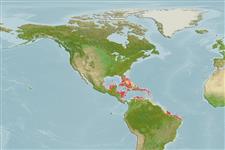>
Blenniiformes (Blennies) >
Labrisomidae (Labrisomids)
Etymology: Paraclinus: Greek, para = the side of + Greek, klinein, kline = sloping and bed, due to the four apophyses of sphenoid bone (Ref. 45335).
More on author: Steindachner.
Environment: milieu / climate zone / kisaran kedalaman / distribution range
Ekologi
laut berasosiasi dengan karang; kisaran kedalaman 0 - 6 m (Ref. 9710). Tropical
Western Central Atlantic: southern Florida, USA and the Bahamas to Central America and northern South America; absent in the Antilles, except for Cuba.
Size / Weight / umur
Kematangan: Lm ? range ? - ? cm
Max length : 10.0 cm TL jantan/; (Ref. 7251)
Duri punggung (Keseluruhan (total)) : 28 - 29; duri punggung lunak (Keseluruhan (total)) : 1; Duri dubur: 2; Sirip dubur lunak: 19 - 20.
Body shape (shape guide): fusiform / normal.
Inhabits seagrass beds and coral reefs. May be found associated with the sponge Verongia fistularis (Ref. 13628). Sexual dimorphism in the shape of the head and dorsal fin (Ref. 5521). Oviparous (Ref. 205). Polygynous males guard the eggs which are spawned by several females in nests (Ref. 55842).
Females deposit eggs in nests often associated with the sponge Verongia fistularis (Ref. 55842). Males fan the eggs for aeration which are probably spawned by several females owing to different developmental stages of eggs present in the nests (Ref. 205). Pairs will spawn routinely in aquaria in the absence of the sponges (Ref. 205).
According to aquarium observations by Breder (1941), "spawning takes place with the female in an inverted position while the male remains upright, wandering females adding to the eggs. The nesting male on sexual exhaustion repulses additional females with a typical warning attitude and eventual biting similar to its reaction to another male or other fish."
Robins, C.R. and G.C. Ray, 1986. A field guide to Atlantic coast fishes of North America. Houghton Mifflin Company, Boston, U.S.A. 354 p. (Ref. 7251)
Status IUCN Red List (Ref. 130435: Version 2025-1)
ancaman kepada manusia
Harmless
penggunaan manusia
Perikanan: komersial; Akuarium: Komersial
Alat, peralatan
laporan khas
muat turun XML
Sumber internet
Estimates based on models
Preferred temperature (Acuan
123201): 23.8 - 28.2, mean 27.3 °C (based on 640 cells).
Phylogenetic diversity index (Acuan
82804): PD
50 = 0.5000 [Uniqueness, from 0.5 = low to 2.0 = high].
Bayesian length-weight: a=0.00933 (0.00410 - 0.02122), b=3.10 (2.91 - 3.29), in cm total length, based on LWR estimates for this (Sub)family-body shape (Ref.
93245).
Trophic level (Acuan
69278): 3.7 ±0.4 se; based on size and trophs of closest relatives
Fishing Vulnerability (Ref.
59153): Low vulnerability (10 of 100).
🛈
Nutrients (Ref.
124155): Calcium = 117 [65, 212] mg/100g; Iron = 0.788 [0.459, 1.317] mg/100g; Protein = 18.9 [17.8, 19.9] %; Omega3 = 0.137 [0.080, 0.231] g/100g; Selenium = 16.5 [8.1, 32.6] μg/100g; VitaminA = 177 [58, 550] μg/100g; Zinc = 2.07 [1.39, 2.93] mg/100g (wet weight);
